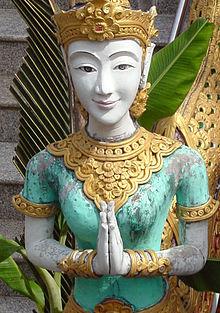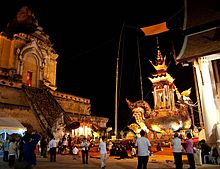Religion
Thailand is nearly 94%-95% Theravada Buddhist (which includes the Thai Forest Tradition and the Dhammayuttika Nikaya and Santi Asoke sects), with minorities of Muslims (5-6%), Christians (1%), Mahayana Buddhists, and other religions.[2] Thai Theravada Buddhism is supported and overseen by the government, with monks receiving a number of government benefits, such as free use of the public transportation infrastructure.
Buddhism in Thailand is strongly influenced by traditional beliefs regarding ancestral and natural spirits, which have been incorporated into Buddhist cosmology. Most Thai people install spirit houses, miniature wooden houses outside their dwellings, where they believe household spirits live. They present offerings of food and drink to these spirits to keep them happy. If these spirits aren't happy, it is believed that they will inhabit the household and cause chaos. These spirit houses can be found in public places and on the streets of Thailand, where the public make offerings. [3]
Prior to the rise of Theravada Buddhism, both Indian Brahmanic religion and Mahayana Buddhism were present in Thailand. Influences from both these traditions can still be seen in present-day Thai folklore. Brahmanist shrines play an important role in Thai folk religion, and the Mahayana Buddhist influence is reflected in the presence of figures like Lokesvara, a form of the bodhisattva Avalokitesvara sometimes incorporated into Thailand's iconography.[3][4]

Customs
The traditional customs and the folklore of Thai people were gathered and described by Phya Anuman Rajadhon in the 20th century, at a time when modernity changed the face of Thailand and a great number of traditions disappeared or became adapted to modern life. Still, the striving towards refinement, rooted in ancient Siamese culture, consisting of promoting that which is refined and avoiding coarseness is a major focus of the daily life of Thai people and high on their scale of values.[5]
One of the most distinctive Thai customs is the wai. Used in greetings, leave-taking, or as an acknowledgement, it comes in many forms, reflecting the relative status of those involved. Generally the salutation involves a prayer-like gesture with the hands, similar to the Añjali Mudrā of the Indian subcontinent, and it also may include a slight bow of the head. This salutation is often accompanied by a serene smilesymbolizing a welcoming disposition and a pleasant attitude. Thailand is often referred to as the "land of smiles" in tourist brochures.
Public displays of affection are not overly common in traditional Thai society, especially between lovers.[6] It is becoming more common, especially among the younger generation.
A notable social norm holds that touching someone on the head may be considered rude. It is also considered rude to place one's feet at a level above someone else's head, especially if that person is of higher social standing. This is because the Thai people consider the foot to be the dirtiest and lowliest part of the body, and the head the most respected and highest part of the body. This also influences how Thais sit when on the ground—their feet always pointing away from others, tucked to the side or behind them. Pointing at or touching something with the feet is also considered rude.

Since a serene disposition is valued, conflict and sudden displays of anger are eschewed in Thai culture. For these reasons, visitors should take care not to create conflict or to display anger. Disagreements or disputes should be handled with a smile and no attempt should be made to assign blame to another. In everyday life in Thailand, there is a strong emphasis on the concept of sanuk; the idea that life should be fun. Because of this, Thais can be quite playful at work and during day-to-day activities. Displaying positive emotions in social interactions is also important in Thai culture.
Often, Thais will deal with disagreements, minor mistakes, or misfortunes by using the phrase mai pen rai, translated as "it doesn't matter". The ubiquitous use of this phrase in Thailand reflects a disposition towards minimizing conflict, disagreements or complaints. A smile and the sentence "mai pen rai" indicates that the incident is not important and therefore there is no conflict or shame involved.
Respect for hierarchy is a very important value for Thai people. The custom of bun khun emphasizes the indebtedness towards parents, as well as towards guardians, teachers, and caretakers. It describes the feelings and practices involved in certain relationships organized around generalized reciprocity, the slow-acting accounting of an exchange calculated according to locally interpreted scales and measures.[7] It is also considered rude to step on any type of Thai currency (Thai coin or banknote) as they include a likeness of the King of Thailand.

There are a number of Thai customs relating to the special status of monks in Thai society. Thai monks are forbidden physical contact with women. Women are therefore expected to make way for passing monks to ensure that accidental contact does not occur. A variety of methods are employed to ensure that no incidental contact (or the appearance of such contact) between women and monks occurs. Women making offerings to monks place their donation at the feet of the monk, or on a cloth laid on the ground or a table. Powders or unguents intended to carry a blessing are applied to Thai women by monks using the end of a candle or stick. Laypersons are expected to sit or stand with their heads at a lower level than that of a monk. Within a temple, monks may sit on a raised platform during ceremonies to make this easier to achieve.
When sitting in a temple, one is expected to point one's feet away from images of the Buddha. Shrines inside Thai residences are arranged so as to ensure that the feet are not pointed towards the religious icons, such as placing the shrine on the same wall as the head of a bed, if a house is too small to remove the shrine from the bedroom entirely.
It is also customary to remove one's footwear before entering a home or the sacred areas within a temple, and not to step on the threshold.

Traditional clothing
Traditional Thai clothing is called chut thai (Thai: ชุดไทย Thai pronunciation: [tɕʰút.tʰaj]) which literally means "Thai outfit". It can be worn by men, women, and children. Chut thai for women usually consists of a pha nung or a chong kraben, a blouse, and a sabai. Northern and northeastern women may wear a sinh instead of a pha nung and a chong kraben with either a blouse or a suea pat. Chut thai for men includes a chong kraben or pants, a Raj pattern shirt, with optional knee-length white socks and a sabai. Chut thai for northern Thai men is composed of a sado, a white Manchu styled jacket, and sometimes a khian hua. In formal occasions, people may choose to wear a so-called formal Thai national costume.
Cuisine[edit]
Main article: Thai Cuisine
Birth traditions and beliefs[edit]
Main article: Birth in Thailand
Traditional principles concerning pregnancy and childbirth are largely influenced by folk beliefs, especially in rural areas of central andnorth Thailand. Modern practices follow the Western medical model.
Nicknames[edit]
See also: Thai names
Thai people universally have one, or occasionally more, short nicknames (Thai: ชื่อเล่น name-play) that they use with friends and family. Often first given shortly after birth by friends or an older family member, these nicknames are overwhelmingly one syllable[8] (or worn down from two syllables to one). Though they may be simply shortened versions of a full name, they quite frequently have no relation to the person's full name and are often humorous and/or nonsense words. Babies may be given a nickname of a relative or named for a characteristic of birth, e.g., "little". Traditionally, nicknames would relate to things of low value, e.g., "dirt", which was to convince evil spiritslurking in the vicinity that the child was not worthy their attention. Today this folk custom is on the decline.
Some common nicknames translate into English as "small", "fatty", "pig", "little", "frog", "banana", "green", or "girl/boy". Though rare, sometimes Thai children are given nicknames in the order they were born into the family (i.e., "one", "two", "three", etc.). Nicknames are useful because official Thai names are often long, particularly among Thais of Chinese descent, whose lengthy surnames stem from an attempt to translate Chinese names into Thai equivalents, or among Thai with similarly lengthy Sanskrit-derived names. In recent years, English language words have become popular nicknames. Examples include: "Ice" (ไอซ์); "Bank" (แบงค์); "New" (นิว); "Ball" (บอล), and even "Beer" (เบียร์).[8]

Funerals
Traditionally, funerals last for at least one week. Crying is discouraged during the funeral, so as not to worry the spirit of the deceased. Many activities surrounding the funeral are intended to make merit for the deceased. Copies of Buddhist scriptures may be printed and distributed in the name of the deceased, and gifts are usually given to a local temple. Monks are invited to chant prayers that are intended to provide merit for the deceased, as well as to provide protection against the possibility of the dead relative returning as a malicious spirit. A picture of the deceased from his/her best days will often be displayed next to the coffin. Often, a thread is connected to the corpse or coffin which is held by the chanting monks during their recitation; this thread is intended to transfer the merit of the monks' recitation to the deceased. The corpse is cremated, and the urn with the ash is usually kept in a chedi in the local temple.
Thai Chinese and Thai Muslim minorities bury their deceased according to the rituals of their respective communities.

National anthem and respect for the flag and king
Twice a day, at 08:00 and again at 18:00, the national anthem is played by all Thai media outlets. Thais stop what they are doing and stand at attention to pay homage to the flag during the anthem. Students in school stand in front of the raised flag and sing the national anthem at 08:00 every school day. The practice dates from 1935 when the regulations for the raising and lowering of the colours was published in the Royal Gazette. The Flag Act of 1979 decreed that those who do not observe the custom by standing in silence during the anthem are subject to a fine of up to 2,000 baht and not more than one year in prison.[9]
In a related practice, the royal anthem of the King of Thailand is played before movies, concerts, and sporting events. All are expected to stand.[citation needed]
0 comments:
Post a Comment